Turn a Mexican Train Dominoes hub and make dominoes more fun. This wood turned domino train station is a little challenging because it involves some refinement after the lathe. You’ll need some face-plate turning experience for this project, but it’s suitable for the advanced beginner.
I played dominoes when I was a child. I don’t remember much as it was a game I played when I was younger. That was until I discovered Mexican Train Dominoes with its domino train station or hub, and metal trains as markers. My wife and I play this game all the time. My version of the rules are at the end of this post. You can download them and print them out to go with this Mexican Train wooden hub wood turning project. The nice thing about a domino train station is that it provides a focal point for the game you are playing. Turning one will make it fancy and enjoyable to play during your family game nights. If you have friends who enjoy dominoes it would make a wonderful gift as well. It is a simple face-plate turning project with a little extra work to make the docking points for the domino trains.
Design Considerations
Dominoes come in a wide variety of material and sizes. This station was designed for my set of dominoes but can be adjusted easily to suit your set. The function of the domino train station is to be the starting point from which each player can build their own train, and one more called the Mexican train. So the station holds the double domino that starts that round. It also holds the token or train for the Mexican train and the trains of individual players as appropriate. Around the outer edge of the station are 8 docking ports where the players’ trains and the Mexican train start from. So the center portion of the station has to be able to hold a single domino. My center circles are 2” in diameter which works for my set of dominoes. Next is a track for the trains to be on. This is ½” wide for this project. Finally you need the docking stations for the individual trains. I made two stations and used shallow docking on one and deeper docking on the other. I turned two stations for this project. The first is made out of cedar and the second is made with Western Larch. With the cedar caution was needed on the reverse chucking so that the wood would not split. I used the tail stock for extra support. I didn’t have to do that with the larch train station.
Turning a domino train station
Prepare the blank for the train station. Starting from the center, I need 1” for the domino, ½” for the track, and 3/4” for the docking stations. This requires a radius of 2 ¼” absolute minimum. Therefore the diameter needs to be greater than 4 ½”. With extra room between each item my train had a diameter of 6 ¼” or so. So depending on the diameter of your blank you can determine how close the three elements have to be on your station. Once you have a prepared blank of a good size then attach the face-plate to the blank.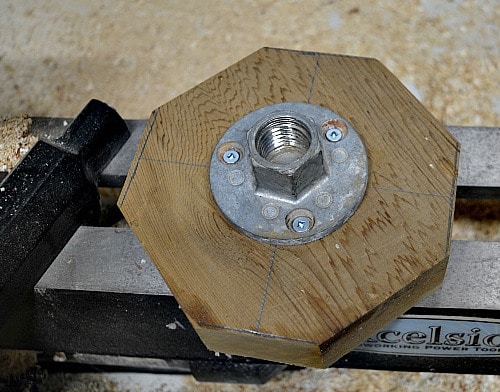
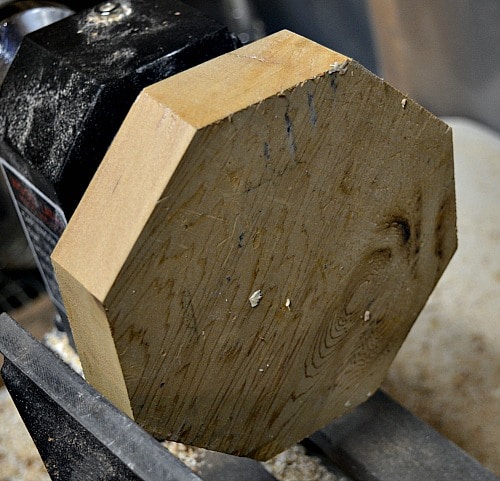
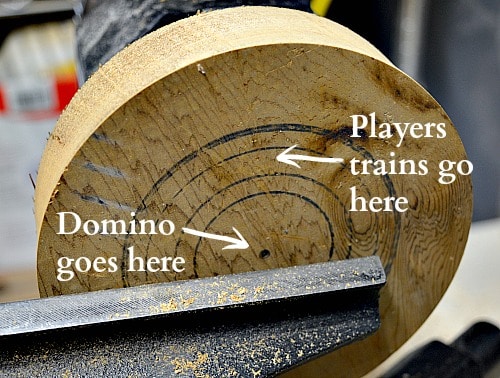
Turning the face of the train station
If you are going to use your domino to determine the diameter then you need to measure across the domino from corner to opposite corner. That is the longest distance that the domino has. I turned the recess with a square scraper. The measurement was precise to these dominoes. With the next train station I made the recess larger. The first one had some wood movement and now the domino fits in easier in some directions than others.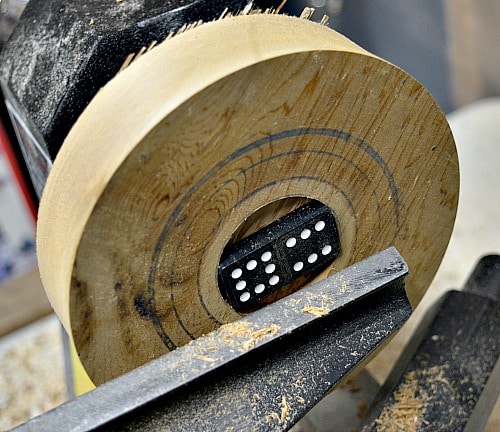
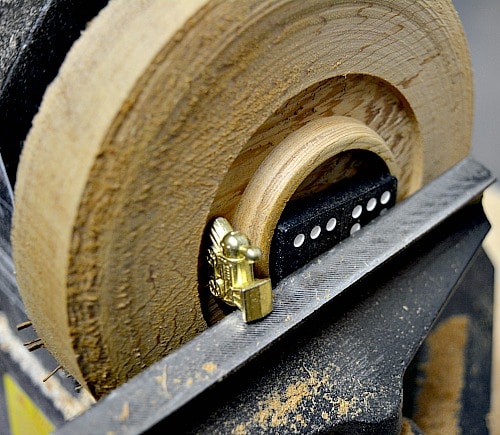
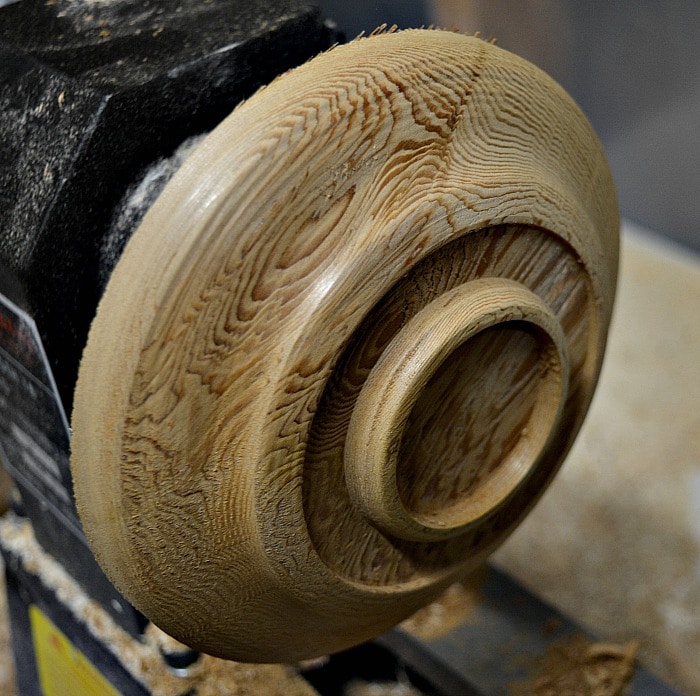
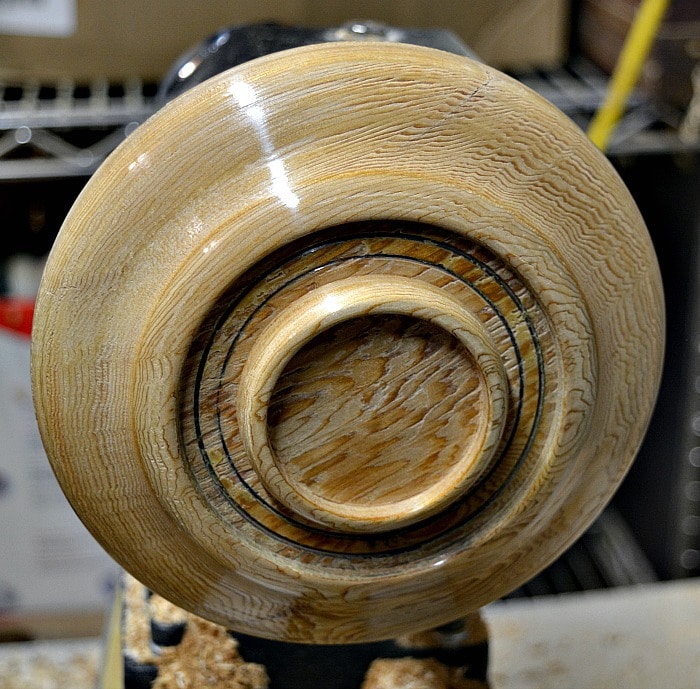
Turning the bottom of the station
Now we need to finish the bottom of the station. With the recess for the center domino, we can easily reverse chuck the station onto the lathe. As this station is made from cedar I carefully expand the jaws into the recess. I don’t want to split the wood.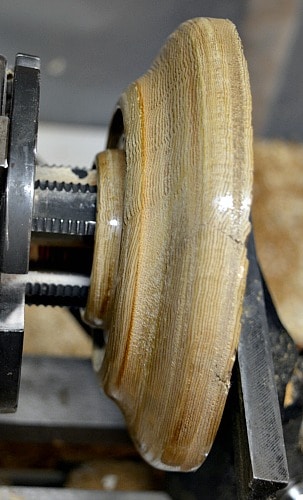
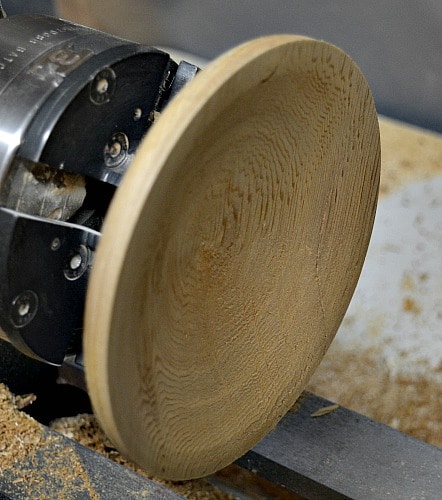
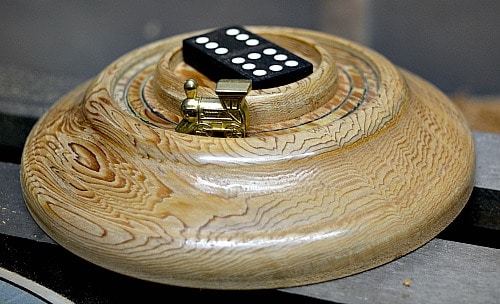
Turning a 2nd domino train station
I quickly took a prepared piece of Western Larch, attached a face-plate to it and turned a second Mexican train station. This is very similar to the cedar one.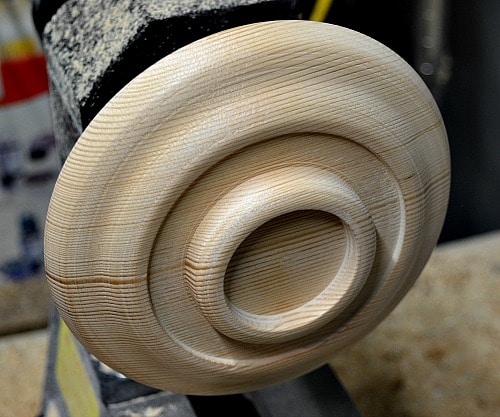

How to make the docking ports
With the cedar station I tried to measure and mark the bottom of the blank while it was on the lathe. It really didn’t work that well and the spacing was close but definitely not equal. Then I had an insight! Take your turning and mark the circumference of the station on a blank piece of paper. Cut the paper into a circle. Fold the paper in half three times and cut out your docking station on the fold. Since you are going to unfold this paper the width of the cut is ½ the width of your dominoes, with the length or depth of the cut is how deep you want to make the docking port.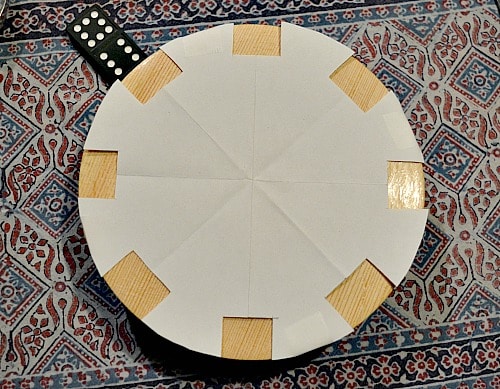
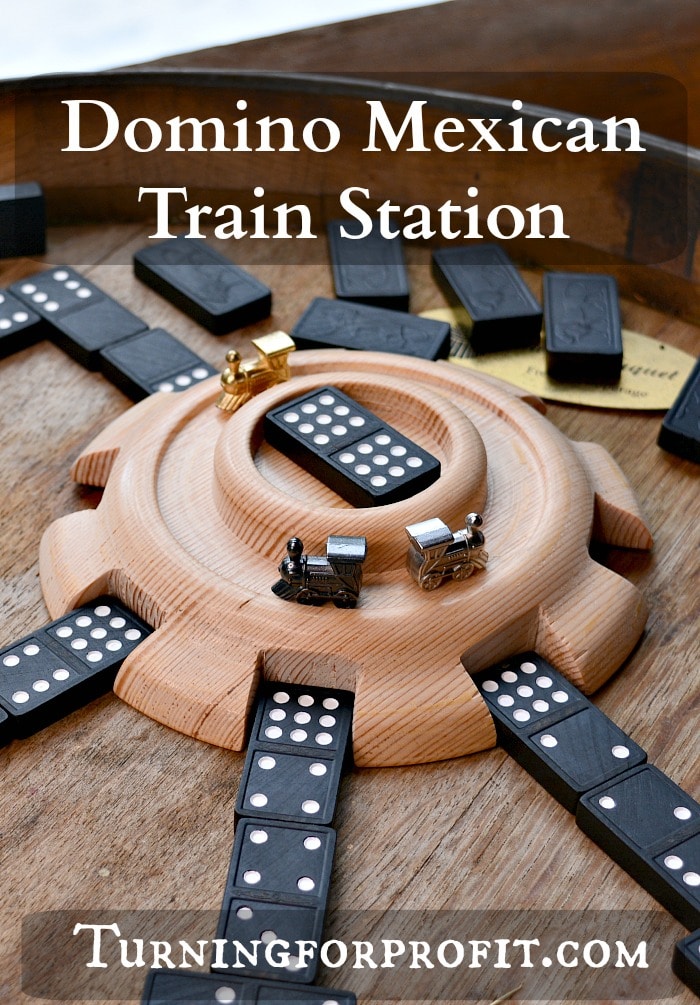
Other things you’ll need to play Mexican Train Dominoes
- For 2 to 4 players you’ll need a double-9 set of dominoes. These sets have 55 tiles. For 4 or more players you’ll have more fun with a double-12 set of dominoes set with 91 tiles. The tiles should be no more than 1 inch by 2 inches to fit in this Mexican Train game hub. My set is a pressed wooden set from the 1980s. You might have one kicking around in your games cupboard. If not, Amazon sells plastic dominoes that will work. Professional domino sets are usually the right size and thickness for this project, but there are cheaper options available. Beware that some cheap modern imported sets are sold with incomplete tiles. You’ll want to check your set immediately on arrival to make sure all the appropriate tiles are there.
- The die cast metal trains that we used are available here on Amazon.
- Official score pads are also available for the double 12 game. We just use pen and paper, but the score pads are fun when you have more than two players.
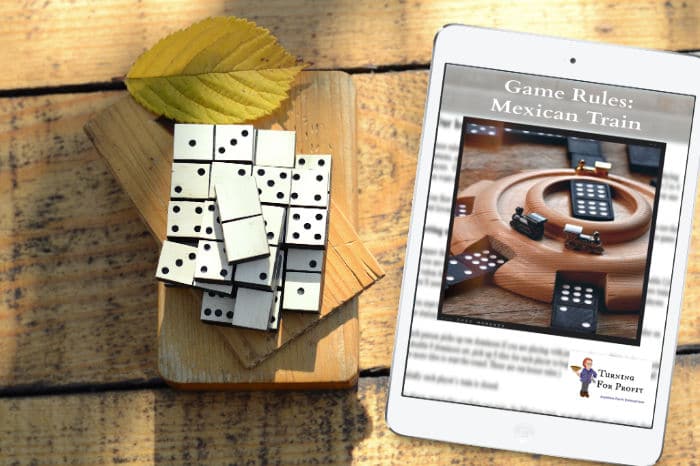
Download the rules for Mexican Train (printable)
Our house rules for Mexican Train Dominoes
These rules are very basic and you can adjust them as needed for your circumstances, playing partners, and age of players, size of your domino set, etc.
Setting up the game
Prepare the game by placing all the dominoes face down except the double nines which is your first double. The face down dominoes is your boneyard. Each player gets a train or token. You will need one more train or token for the Mexican train. You start the game with double nines on the station. The Mexican train is also on the station. Initially each player’s train is closed. If a player cannot play on their own train, the Mexican train, or another player’s open train then they must place a Mexican train marker on the station at the head of their tiles. Their train is now open. Each person picks up ten dominoes. You only play one tile at a time (except for doubles see below). Pick a person to start the round. (next round starts with the next person) Organize your tiles and start by matching the number of dots on the tile in the station.
Playing the game
On the first turn each player tries to start their own train. When a person cannot play any tile from their hand they have to pick up a tile. If they can play that tile, they do so and play continues to the next player. If they can’t make a play then their train becomes open (or remains open). Playing a double. Double tiles are turned perpendicular to the train. You can play as many doubles as you want where you can legitimately play. Usually that means your train and the Mexican train. If another player’s train is open you can play a double there as well. Your last tile in your turn must be a non-double unless it is your last tile. If you finish with a double and can’t play from your hand you have to pick up a tile from the remaining dominoes and try to play that one. When a double is played it must be finished by either the person who played the tile or the first player who has a tile that matches the double. In other words you can’t play anywhere else except the double until it is closed. If more than one double is open they must be closed in the order that they were played.
When you play a tile and you only have one left you are to alert the other players that you are about to go out by tapping your last domino on the table. If you do not tap then you have to pick up another domino before you can go out. The round is over when one player plays their last tile. It is also over when all the tiles have been picked up from the boneyard and no one can make a play.
Keeping score
We do not keep score since it is just the two of us. To keep score, at the end of each round, you tally up the pips on the dominoes remaining in each player’s hand. With the double nine set you will play ten rounds. The player with the lowest total score is the winner. We did not give the double blank any extra value when we did keep score. My wife and I follow these rules and have a great time relaxing with each other, enjoying coffee, and a game of dominoes. We aren’t very competitive though. It’s how we’ve stayed together for 38 years. (Happy wife. Happy life.) But, if you like lots of high energy competition you may enjoy the double 12 set and a score pad for added fun.
Your Turn:
This was a good challenging project that turned out quite nicely. What games have you turned, all or a portion of, on your lathe? Leave a comment below. Thanks.






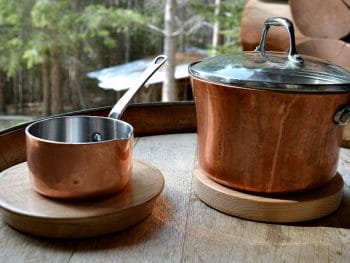
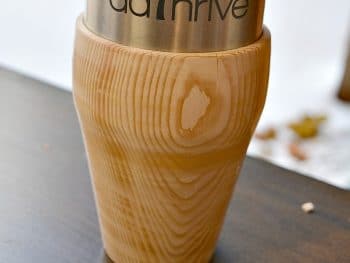
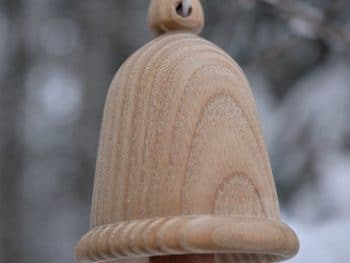


This looks like a great project Robin. We have played Mexican Train for many years and this would add another fun element to the game.
Robin,
The Mexican Train Station plans has me confused. The picture shows 3 miniature trains on their tracks and 8 ports. Should there not be 8 trains, one for each player?
Thank you,
Ed Lynn
Hi Ed. You would need a total of 8 trains for 7 people to play plus one Mexican Train. You only have trains on the track when your train is public so it would be rare to have all the trains at the station at one time. At the start of the game there would only be one train for the Mexican train. Hope that helps.
What a great idea and game not herd of this game before.
You and your family have a Happy New year
Paul R Brown
Robin
A great turning p project and a fun game for all ages. My question is what web site do you use to purchase the miniature trains?
Thanks
Doug
Thank you for your question. I’ve added a link to the post! Guess I needed the reminder. Enjoy your turning and the game!
Your train tracks look like they are burned in, but you say no, they are grooves. Whatever, I would like to burn them in, I would appreciate any suggestion.
Thank you,
Eddie Lynn
HI Robin
Great little project. My wife and I are trying to determine your height of the station.
Thanks for all you share.
Jim
The height of the station is about 1.5″. Shape your hub based on the thickness of your turning blank. I would recommend something that would be twice the thickness of your dominoes as a minimum.
has anybody made these that I can purchase?